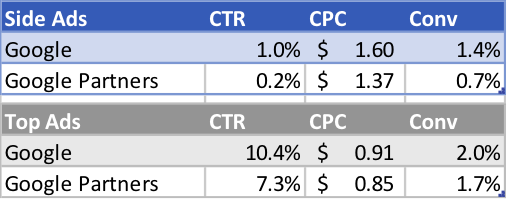Automatic bidding algorithms have been a part of paid search tool sets for a long time and artificial intelligence is gaining more and more traction every day.
While I think this is a tidal wave of information and computing power that’s coming towards every industry, I also think that there are very important strategic decisions that will always be in the hands of the search marketer.
One of those most often debated is the value of a top position. Many find themselves bidding to a top position simply because it feels like winning (which is a fantastic reason why removing human emotions in marketing decisions could be a great thing – score one for AI).
It is innately good to see your brand at the top of a search page, but I wanted to take a look at the difference between the top and side position. How does the rank of your ad impact its results? Does it differ on Google vs. their search partners? The findings were very interesting.
Top vs. Side
I started looking at data across the last 13 months across all verticals and terms. There is a point to be made about excluding branded terms, but for now I included them simply because they often will be displayed as a side ad even if they are the only ad in the auction.
This data can be pulled from Google using the Top vs. Other segment where you can pull this data for specific levels of your own accounts and brands.
The differences when combining all search traffic (Google + Partners) makes a very compelling case for top placements.
Not only does the user click-through on top ads at 10% (compared to 0.5% for the side), but the conversion rate is almost twice as high and the cost-per-click is significantly less. What could be better than that?
Another way to look at it is for every 100,000 impressions, the top ad position would net 3,349% more sales at a 63% lower cost per acquisition.
Again, I think branded terms have some level of impact to this analysis, but I think the idea that consumers have a better branded association with top ranked ads on the search results page is true.
Google vs. Partners
The difference for the partner network also tells a pretty interesting story.
The mothership outperforms the partner network in click through rate and conversion rate. This does however come at a premium. The CPCs are slightly higher.
Overall the Google domain yields a better CPA by 7% for side ads and 40% for the top ads more than offsetting the increase in cost per click.
According to the most recent earnings report, Google saw a 2% growth in partner traffic vs. a 40% growth in their own traffic. I’m sure that some of the shifts in their partner network have a lot to do with this, but maybe advertisers are getting savvier with their data and opting out of the partner network for these very reasons.
What should you do with this info?
- Dig into your own metrics. Measuring top position is almost never the right metric to judge success, however understanding the building blocks that make up your success is important.
- Consider if the search network is right for you. If you have a constrained budget it probably doesn’t make sense to extend your full keyword list to the partner network. This doesn’t have to be and shouldn’t be an all or nothing proposition. Determine the right keyword set or campaigns that perform best for you across the networks. The same can be said for extending your campaigns to Yahoo! and Bing.
Data is the best part of being a search marketer. I’ve said it a million times before, data is what separates success from failure in this business and it’s simple data like this that can help uncover some great opportunities for your business.
The article Bidding for top position on a SERP: what does it get you? was first seen from https://searchenginewatch.com


No comments:
Post a Comment